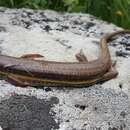tr
kırıntılardaki isimler


Der Berberskink (Eumeces schneiderii, Syn.: Novoeumeces schneiderii), auch Schneiders Skink oder Tüpfelskink genannt, ist eine Echsenart, die von Nordwestafrika bis Nordwestindien verbreitet ist. Benannt wurde sie nach dem deutschen Naturforscher Johann Gottlob Theaenus Schneider.
Das Verbreitungsgebiet reicht von Algerien über Tunesien, Libyen und Ägypten bis nach Anatolien, Saudi-Arabien, Dagestan, Usbekistan, Tadschikistan und Nordwestindien. Auch auf Zypern kommt der Berberskink vor.
Der Berberskink erreicht je nach Unterart eine Gesamtlänge von 32 bis 47 cm. Sein Körper ist walzenförmig, die Beine kurz und stämmig. Die Grundfarbe der Echsen ist bräunlich, die Seiten sind eher gelblich, der Bauch gelblich oder schmutzigweiß. Auf der Rückenseite und den Flanken der Echsen finden sich unregelmäßig oder in Reihen angeordnete orangerote Flecken oder gelbe, schwarz umrandete Schuppen. Die Ohröffnungen können beim Wühlen im Boden verschlossen werden.
Der Berberskink kommt in Halbwüsten und in trockenem Kulturland vor. Er ist tagaktiv und versteckt sich in der Nacht unter Steinen und Büschen. Als Nahrung dienen Insekten, Spinnen, Gehäuseschnecken und Pflanzenteile.
Während der Paarungszeit sind sie territorial und gegeneinander aggressiv. Weibchen werden vom Männchen verfolgt und ihre Paarungsbereitschaft durch Lecken in der Kloakengegend geprüft. Fünf bis sechs Wochen nach der Paarung legt das Weibchen drei bis zwanzig Eier an einer leicht feuchten Stelle ab. Die Jungskinke schlüpfen nach 8 bis 9 Wochen. Sie sind, abweichend von den ausgewachsenen Berberskinken, graubraun bis olivgrau gefärbt und besitzen 8 bis 10 Längsreihen von weißen Punkten. Der orangefarbene Streifen auf den Körperseiten fehlt.
Der Berberskink (Eumeces schneiderii, Syn.: Novoeumeces schneiderii), auch Schneiders Skink oder Tüpfelskink genannt, ist eine Echsenart, die von Nordwestafrika bis Nordwestindien verbreitet ist. Benannt wurde sie nach dem deutschen Naturforscher Johann Gottlob Theaenus Schneider.
Eumeces schneiderii, commonly known as Schneider's skink or the Berber skink, is a species of lizard in the family Scincidae. The species is endemic to Central Asia, Western Asia, and North Africa. There are five recognized subspecies.
Both the specific name, schneiderii, and one of the common names, Schneider's skink, are in honor of German zoologist Johann Gottlob Theaenus Schneider.[3]
The subspecific name, barani, is in honor of Turkish herpetologist İbrahim Baran.[4]
E. schneiderii has the following characters: Head moderate; snout short, obtuse. Nasal rather large, usually divided, in contact with the two anterior upper labials; no postnasal; 5 supraoculars, the three anterior in contact with the frontal; parietals entirely separated by the interparietal; 4 or 5 pairs of nuchals; ear-opening rather large, with 4 or 5 long pointed lobules anteriorly; 2 azygos postmentals. 22 to 28 scales round the middle of the body, perfectly smooth, the laterals smallest, those of the two median dorsal series very broad and larger than the ventrals. The length of the hind limb is contained 2.5 to 3 times in the length from snout to vent. When pressed against the body, the limbs just meet or fail to meet. A series of transversely enlarged subcaudals.[5]
Olive-grey or brownish above, uniform or with irregular golden-yellow spots or longitudinal streaks; a yellowish lateral streak, extending from below the eye to the hind limb, is constant; lower surfaces yellowish white.[5]
Size: from snout to vent, 16.5 cm (6.5 inches); plus tail, 20 cm (8 inches).[5]
Four subspecies are recognized as being valid, including the nominotypical subspecies.[2]
Nota bene: A trinomial authority in parentheses indicates that the subspecies was originally described in a genus other than Eumeces.
E. schneiderii is found in Eastern Algeria, Tunisia, Libya, Egypt,[6] Israel, Cyprus, Turkey, western Syria, Lebanon, Jordan, Iran (Kavir desert), Iraq, Saudi Arabia, Transcaucasia, Russia (Dagestan), Turkmenistan, Uzbekistan, Tajikistan, eastern Georgia, southern Armenia, Azerbaijan, Asia Minor, Afghanistan, northern Pakistan, northwestern India.
The preferred natural habitats of E. schneiderii are rocky areas, grassland, shrubland, and wetlands, at altitudes of 150–1,800 m (490–5,910 ft).[1]
E. schneiderii is oviparous.[2]
Eumeces schneiderii, commonly known as Schneider's skink or the Berber skink, is a species of lizard in the family Scincidae. The species is endemic to Central Asia, Western Asia, and North Africa. There are five recognized subspecies.
El escinco naranja de Shneider (Eumeces schneideri) es una especie de escíncido que habita en el centro y oeste de Asia y en el norte de África. Su nombre es un reconocimiento al zoólogo alemán Johann Gottlob Schneider.
El escinco naranja de Shneider (Eumeces schneideri) es una especie de escíncido que habita en el centro y oeste de Asia y en el norte de África. Su nombre es un reconocimiento al zoólogo alemán Johann Gottlob Schneider.
Eumeces schneideri est une espèce de sauriens de la famille des Scincidae[1].
Cette espèce se rencontre[1] :
Selon Reptarium Reptile Database (18 décembre 2013)[2] :
Cette espèce est nommée en l'honneur de Johann Gottlob Schneider[1],[3].